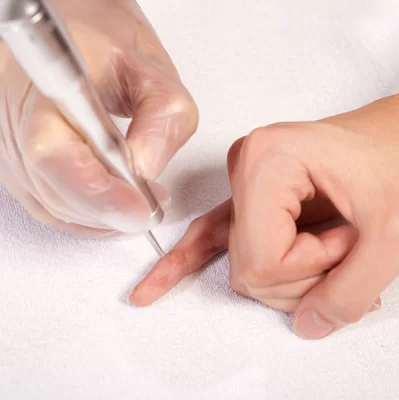How to get rid of warts?
- What are warts and where do they come from?
- What are some home remedies for warts?
- What wart treatments are available at the pharmacy?
- What treatments for removing warts can a doctor perform?
- How to get rid of warts in children?
- When should you see a doctor about a wart?
- How to prevent the formation and recurrence of warts?
Warts, also known as viral warts, are benign skin growths caused by the HPV virus. It enters the body through minor skin damage, such as small cuts or abrasions. Infection can occur through direct contact as well as touching contaminated objects.
Warts appear as hard, rough lumps, often resembling cauliflower. Black dots are often visible on them, which are actually tiny blood vessels.
There are several types of warts. The most common ones include common warts (mostly found on the hands) and plantar warts (appearing on the feet and often causing pain). Flat warts typically appear on the face, while genital warts occur in the genital area.
Home remedies for warts often use natural ingredients. Many people opt for proven methods in the hope of reducing unwanted skin changes. Therapies include:
- celandine juice, which is intended to inhibit the division of wart cells,
- garlic compresses, valued for their antiseptic properties,
- apple cider vinegar, whose effects are sometimes compared to salicylic acid,
- essential oils, such as tea tree or lemon oil,
- dandelion juice,
- aloe vera,
- special pastes.
However, it's worth remembering that the effectiveness of these home methods has not been scientifically confirmed. Moreover, their use may lead to skin irritation, and the results obtained are very diverse because each body reacts differently to them.
When home remedies for warts are not sufficient, over-the-counter pharmacy products can help. They can be divided into two main categories: keratolytic preparations and cryotherapy kits.
Keratolytic preparations, available as liquids, gels, ointments, and even patches, contain substances such as salicylic acid, lactic acid, or TCA. Their task is to gradually exfoliate the epidermis, leading to the disappearance of the lesion.
Another effective method of treating warts is cryotherapy, which involves freezing warts at home. A popular solution is also silver nitrate, commonly known as "devil's stone." This caustic agent comes in a stick form and requires particularly careful use - always protect the healthy skin around the treated lesion.
When home remedies and over-the-counter products prove ineffective in fighting warts, a specialist comes to the rescue – a dermatologist or podologist, who will professionally remove the bothersome growths.
One of the popular methods of combating warts is cryotherapy, which uses liquid nitrogen. Another commonly used technique is laser therapy, typically using a CO2 laser that precisely vaporizes the wart tissue. This procedure is carried out under local anesthesia. It is also worth mentioning electrocoagulation, which involves burning skin lesions with high-frequency current.
However, when warts prove to be exceptionally resistant, a specialist may opt for more invasive procedures, such as surgical treatment. This may involve curettage or excision of the growth with a scalpel. The ultimate choice of treatment method depends on many factors, including the type, size, and location of the wart.
Warts often appear in the youngest children, but usually resolve spontaneously. However, it is always worth consulting a doctor - a pediatrician or dermatologist will assess the situation. A young child's body often has weaker immunity, and delicate skin is more prone to micro-traumas, which promotes the development of these changes.
If treatment is necessary, the specialist will choose safe and minimally invasive methods. Low-concentration salicylic acid ointments are often used. Cryotherapy kits are also available, although these are intended for children over 4 years of age.
In the case of warts resistant to standard therapies, the doctor may consider a different approach. After a thorough dermatological assessment, a decision may be made to perform a procedure in the office. Proper hygiene is also extremely important. By teaching a child to care for cleanliness, it is possible to effectively stop the spread of the virus.
When it comes to warts, it is always worth consulting a dermatologist. This is crucial for proper treatment and monitoring of new changes.
Immediate intervention by a specialist is required for warts that:
- bleed,
- grow quickly,
- change color,
- cause pain,
- cause inflammation,
- appear in large numbers,
- do not improve despite using over-the-counter products for several weeks.
Consultation with a specialist should also be considered by:
- individuals with diabetes,
- individuals with circulation problems,
- pregnant women,
- breastfeeding women.
In these cases, professional help is essential to minimize the risk of complications and prevent wart recurrence.
To effectively prevent warts and their recurrence, it is worth remembering a few prevention rules.
- Maintain personal hygiene - regularly wash your hands and feet.
- In public places, such as pools, always wear protective footwear, e.g. flip-flops.
- Avoid sharing personal items, such as towels, socks, or foot care accessories.
- Boost your immune system through a healthy lifestyle, balanced diet, and, if necessary, appropriate supplementation.
- Remember to regularly moisturize the skin, which strengthens its natural protective barrier.
- Avoid biting nails and cuticles, as it opens the way for infections.
- Ensure that your feet are always dry and wear breathable footwear that allows your feet to breathe.
- Consider HPV vaccinations, which can protect against some types of viruses responsible for warts.

